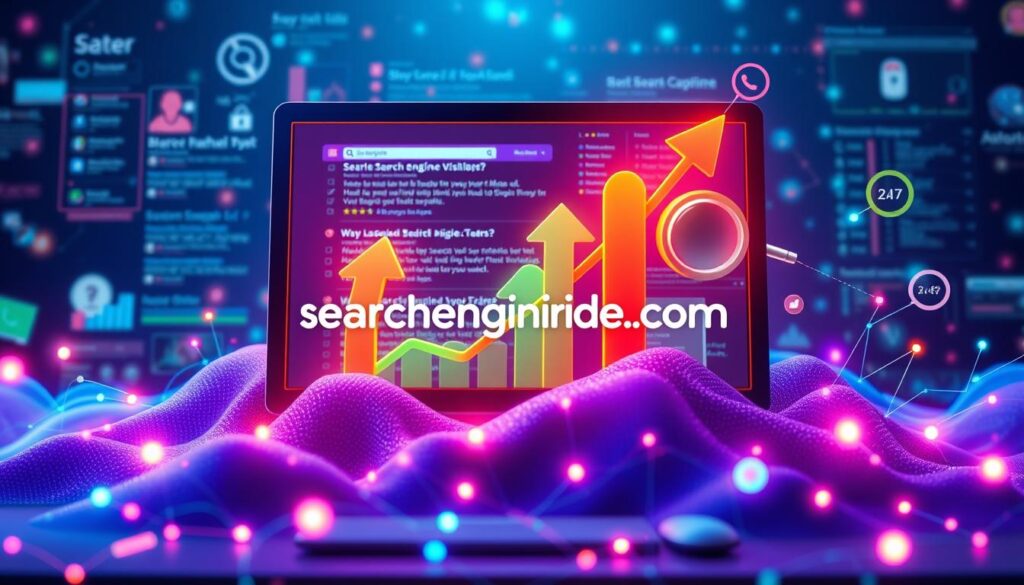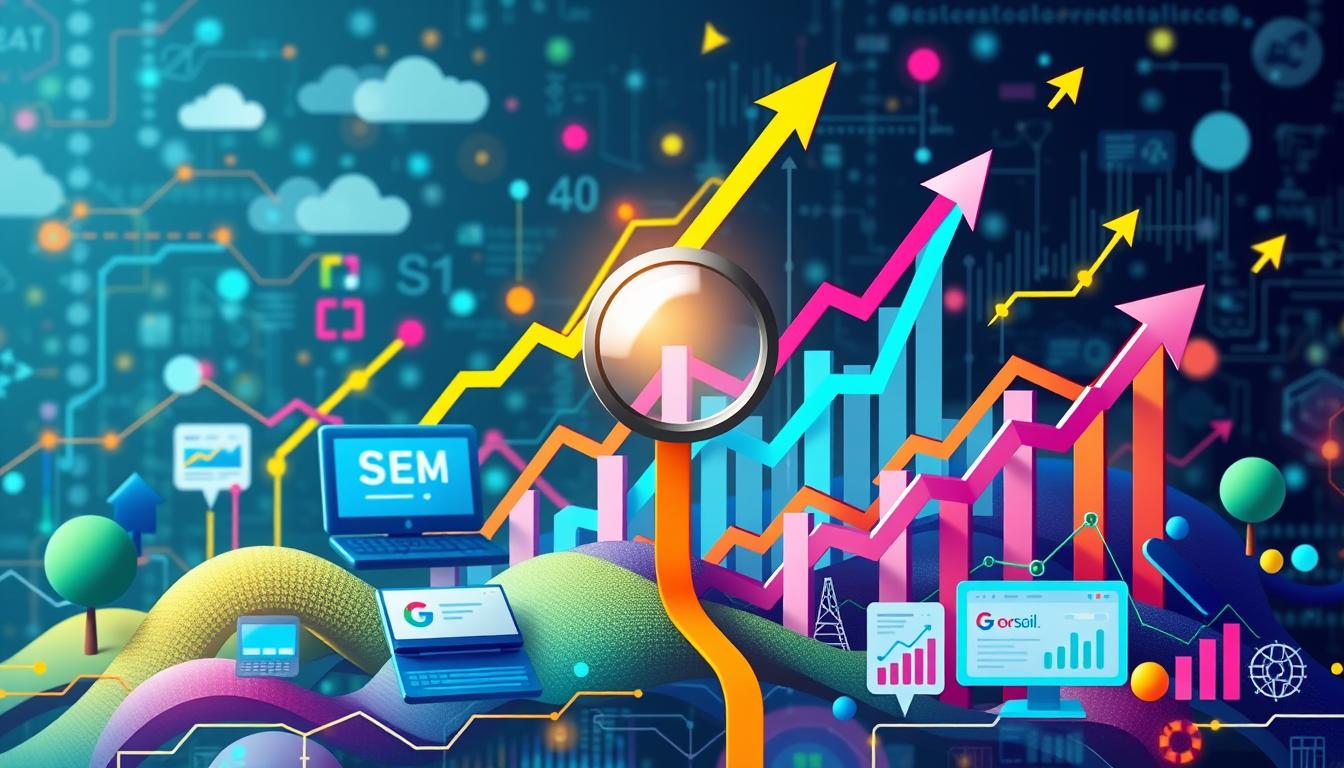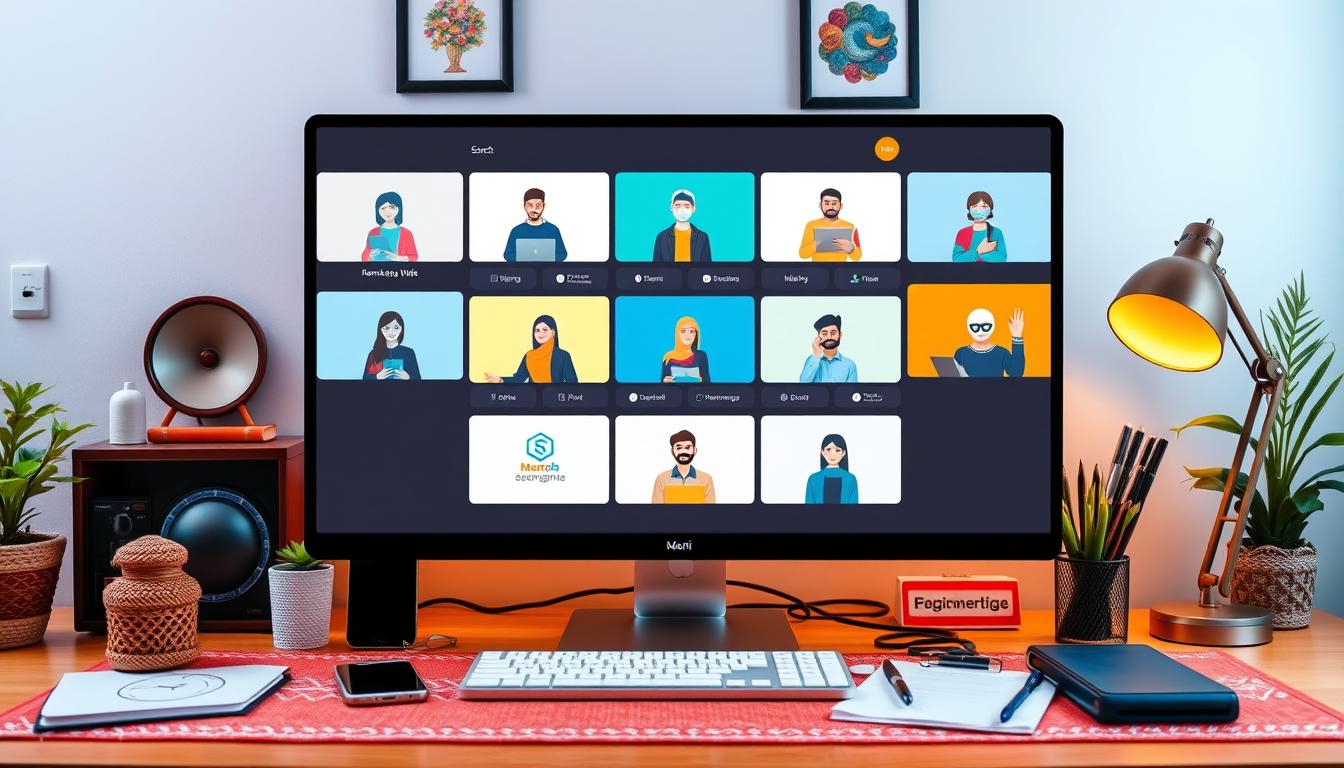In today’s digital world, making sure your business is seen online is key. But how do you tackle the complex world of SEO and SEM? This article is your guide to these powerful digital marketing tools. It will help boost your online presence.
Are you ready to increase your web traffic and search rankings? Learn how to conquer the search engine world and lead your industry online.
Key Takeaways
- Understand the fundamental differences between SEO and SEM, and how to leverage both for maximum impact.
- Learn how to conduct thorough keyword research to identify the most valuable opportunities for your business.
- Explore on-page optimization techniques to ensure your website is fully optimized for search engines and user experience.
- Discover effective link-building strategies to improve your search rankings and online authority.
- Uncover the power of integrating SEO and SEM for a comprehensive digital marketing approach.
Understanding SEO and SEM: The Keys to Online Success
In today’s digital world, search engine optimization (SEO) and search engine marketing (SEM) are key. They help your website get seen and attract the right visitors. Knowing how to use these strategies is vital for success online.
What is SEO?
SEO makes your website better for search engines. It uses keywords and improves user experience. This way, your site gets more organic traffic from search engine users.
What is SEM?
Search engine marketing (SEM) is about paid ads. It uses pay-per-click (PPC) to bring visitors to your site. This way, you can show your business to people looking for what you offer.
SEO and SEM work together well. They help your website be seen more and get more qualified leads from search engines.
| SEO | SEM |
|---|---|
| Focuses on optimizing website content and structure to improve organic search engine rankings | Utilizes paid advertising platforms, such as Google Ads, to drive targeted traffic to your website |
| Aims to increase website visibility and attract organic traffic | Allows for immediate website visibility and control over ad targeting |
| Requires ongoing maintenance and adaptation to search engine algorithm changes | Offers more instant and measurable results, but requires a consistent budget |
By knowing how SEO and SEM work, businesses can make a strong digital marketing plan. This plan uses search engine visibility to grow and succeed.

The Importance of Search Engine Visibility
In today’s digital world, search engine visibility is key for your business or brand’s success. When your site shows up high in search results, more people find you. This leads to better online discoverability, more brand awareness, and higher website traffic. You also get more customer acquisition.
Getting noticed in search engines is more than just getting more visitors. It’s about meeting your audience when they need what you offer. By ranking high, you show you’re a trusted and knowledgeable source. This grabs the attention of those ready to buy from you.
| Benefits of Strong Search Engine Visibility | Impact |
|---|---|
| Increased online discoverability | Your brand becomes more visible and accessible to potential customers searching for your products or services. |
| Enhanced brand awareness | Consistently appearing in search results reinforces your brand’s credibility and position in the market. |
| Higher website traffic | More people are drawn to your website, leading to potential sales and customer engagement. |
| Improved customer acquisition | Increased visibility helps you reach and convert more qualified leads into paying customers. |
By focusing on search engine visibility, you open doors for your business. You can build a stronger online presence and drive growth through targeted customer acquisition. It’s a vital part of any digital marketing plan, helping your brand stand out online.

Conducting Keyword Research for seo sem
Keyword research is key for SEO and SEM. It helps you find the right words to use online. This way, you can reach more people and show up better in search results.
Identifying Relevant Keywords
Start by making a list of keywords that fit your business. Think about what your customers might search for. Look at these things:
- Relevance to your industry and offerings
- Popularity and search volume
- Commercial intent (e.g., “buy,” “purchase,” “hire”)
- Demographic and geographic targeting
Analyzing Keyword Competition
After you have your list, check how competitive each keyword is. Keyword competition is how many others are also after the same keywords. Knowing this helps you pick keywords that are not too hard to rank for.
Look at these metrics to understand competition:
- Search volume: How many people search for a keyword each month.
- Keyword difficulty: How hard it is to rank for a keyword, based on other websites’ quality.
- Cost-per-click (CPC): What advertisers pay for a click on a keyword.
By looking at these, you can find the best keywords. Then, you can make a strong SEO keyword optimization and SEM keyword targeting plan.
On-Page SEO Optimization Techniques
SEO is more than just finding the right keywords and building links. It’s also about optimizing your website’s content. This includes things like title tags and meta descriptions. These elements help search engines understand and rank your pages, which affects your online visibility.
Optimizing Title Tags and Meta Descriptions
Title tags and meta descriptions are your website’s first impression. They tell search engines what your pages are about and try to get users to click on them. By optimizing these elements, you can improve your site’s ranking in search results.
Here are some tips for making the most of title tags and meta descriptions:
- Put your main keywords in the title tag, but keep it short, around 50-60 characters.
- Write meta descriptions that are catchy and tell what the page is about, within 155 characters.
- Make sure each page has its own unique title tag and meta description to avoid duplicates.
- Include a clear call-to-action in your meta descriptions to get users to take action.
- Keep an eye on and update your title tags and meta descriptions regularly to keep them effective.
By focusing on these on-page SEO elements, you can boost your website’s search engine ranking. This leads to more targeted traffic and better online success.
Content Optimization for User Experience
In the fast-paced world of SEO, making content that speaks to your audience and meets search engine standards is key. This approach boosts your site’s visibility, engagement, and conversion rates. It’s all about optimizing for user experience.
Focus on what your audience wants to find. Use keywords that match their search queries. This makes your content valuable and relevant, improving both user experience and search rankings.
Optimizing for Readability and Engagement
Don’t forget about making your content easy to read and engaging. Use short paragraphs, subheadings, bullet points, and tables. This makes your content scannable and keeps your audience interested. It also boosts your site’s conversion rates.
Leveraging Multimedia Content
Adding images, videos, and infographics can make your content more engaging. These elements not only break up text but also improve engagement and search engine rankings.
| Content Optimization Tactics | Benefits |
|---|---|
| Prioritize user intent | Improve relevance and value for your audience |
| Optimize for readability and engagement | Enhance the overall user experience |
| Leverage multimedia content | Boost engagement metrics and search engine visibility |
By using these strategies, you can create a user-friendly experience. This experience meets your audience’s needs and search engine standards. It leads to better visibility, engagement, and website conversion rates.
Link Building Strategies for Better Rankings
In the world of SEO, link building is key to better rankings and more website authority. By using good internal linking and getting quality external backlinks, you can attract more visitors. This makes your site a go-to place in your field.
Internal Linking Practices
Internal linking connects pages on your site. It’s great for both users and search engines. By adding links in your content, you make your site easier to navigate and more SEO-friendly.
- It makes your site easier to explore, helping visitors find more content.
- It spreads out “SEO juice” to all your pages, boosting their rankings.
- It shows search engines how your site is structured and what’s important.
External Link Acquisition
Getting quality external backlinks is also crucial. It helps improve your rankings and site authority. Links from trusted sites show search engines your content is valuable.
- It makes your link profile more diverse, showing your content is shared widely.
- It uses other sites’ authority to boost your own, making you more visible in searches.
- It brings in more visitors from the linking sites, growing your audience.
Quality, relevance, and diversity in links are more important than quantity. Building lasting relationships with other sites in your field creates a strong link profile. This supports your SEO efforts over time.
Leveraging Social Media for SEO and SEM
Social media platforms are now key in your SEO and SEM strategies. They help spread your content, increase brand awareness, and bring more visitors to your site. This boosts your search engine ranking.
Social media marketing creates social signals that search engines value. When people share, like, and comment on your posts, it tells search engines your content is good. This can make your site rank higher and attract more visitors.
Sharing your content on social media also makes your brand more visible. This can reach more potential customers. By posting interesting and valuable content, you can gain new followers. This can lead to more website visits and a stronger online presence.
| Social Media Platform | Benefits for SEO and SEM |
|---|---|
| Generates social signals, enables content sharing, and enhances brand awareness | |
| Facilitates real-time engagement, boosts visibility through hashtags, and provides opportunities for link sharing | |
| Establishes thought leadership, enhances professional credibility, and enables content distribution to a targeted audience | |
| Leverages visuals to create a strong brand identity, encourages user-generated content, and drives engagement |
Combining your social media marketing with SEO and SEM can greatly benefit your business. Keep an eye on your social media stats and tweak your strategy as needed. This will help you get the most out of your social media efforts for better search engine results.
Measuring and Analyzing SEO Performance
Effective SEO analytics and performance tracking are key for making smart decisions. They help improve your website’s visibility and success. By watching important performance indicators (KPIs), you can keep making your SEO strategy better and get better results.
Tracking Key Metrics
The main KPIs for SEO include:
- Organic traffic – Keep an eye on the visitors coming to your site from search engines.
- Search rankings – Check your ranking for key words on big search engines like Google.
- Conversion rates – See how many visitors do what you want them to, like buying or filling out forms.
- Bounce rate – Find out how interested users are in your site’s content.
- Time on page – See how long visitors spend looking at your content.
Looking at these SEO metrics often will show you where to get better. It helps you make data-driven decisions to boost your website’s performance.
“The key is to measure the right KPIs and use that data to continually refine your SEO approach.” – SEO Expert, Jane Doe
By keeping a close eye on your SEO analytics and performance, you can make sure your site reaches the right people. It will engage them well and help you achieve your online goals.
SEM: Paid Search Advertising Strategies
In the digital marketing world, search engine marketing (SEM) is key. It boosts online visibility and brings in targeted traffic. A big part of SEM is pay-per-click (PPC) ads. These ads help businesses reach their audience through sponsored search engine spots.
Understanding Pay-Per-Click (PPC) Advertising
PPC ads work in a simple way. Businesses create ads and bid on keywords. When users click on these ads, the business pays a set fee to the search engine. This method helps businesses get quick exposure to people looking for what they offer.
To make your PPC ads work better, focus on ad targeting and ad optimization. Pick the right keywords, write catchy ad copy, and keep improving your campaigns. This way, you can get the best results from your paid ads.
For successful search engine marketing with PPC, you need to know your audience well. You also need to keep an eye on ad optimization and be ready to tweak your paid advertising plans often. By getting good at these, you can make the most of PPC campaigns and boost your brand online.
Integrating SEO and SEM for Maximum Impact
In the fast-paced world of digital marketing, combining SEO and SEM is key. This mix boosts your online presence, attracts the right visitors, and increases your ROI. It’s a powerful way to grow your business online.
Using both SEO and SEM together brings many benefits. SEO and SEM integration balances organic and paid search. This digital marketing synergy helps your brand reach the right people at the right time. It makes your website more credible and boosts your online strategy.
When done right, SEO and SEM together can lead to great results. By matching your keyword research, content, and link building, you can improve ROI and grow your business. This approach improves your organic search rankings and paid ads, making your online success even stronger.
Choosing to use SEO and SEM integration is a smart move. It takes your digital marketing to new levels. By combining these two, you open up many opportunities and make your brand stand out in the online world.
“Integrating SEO and SEM is not just a best practice, but a necessity in today’s digital landscape. By aligning these strategies, businesses can achieve unparalleled visibility and drive remarkable results.” – Digital Marketing Strategist
Staying Ahead of Algorithm Updates and Trends
The world of SEO and SEM is always changing. Search engines update their algorithms often, and new trends pop up. To stay ahead, it’s key to keep up with these changes and adjust your strategies.
Algorithm updates can really affect your website’s visibility. By watching the latest search algorithm updates, you can tweak your SEO strategies. This makes sure your content and site structure match the search engines’ new rules.
It’s also vital to follow the latest SEO trends. Using industry best practices and adaptive digital strategies can open up new chances. It keeps you ahead of the game.
| Algorithm Updates | SEO Trends |
|---|---|
| Panda | Voice Search Optimization |
| Penguin | Video Content Optimization |
| Hummingbird | Mobile-First Indexing |
| Rankbrain | Topic Clustering |
By keeping up and adapting your SEO and SEM strategies, your website can thrive. It will succeed in the fast-changing digital world.
“Staying ahead of the curve is not just a luxury, it’s a necessity in the fast-paced world of digital marketing.” – SEO Expert
Hiring an SEO/SEM Agency or Consultant
If your business doesn’t have the skills or resources for SEO and SEM, getting help from an SEO agency or SEM consultant is smart. They have lots of digital marketing expertise. They can guide you through SEO and SEM’s complex world.
Outsourcing your SEO and SEM can bring many benefits. You get specialized knowledge, cost-effective solutions, and can focus on your main business. A top SEO agency or SEM consultant will create strategies to boost your online presence. This can lead to more traffic, sales, and revenue.
Finding the Right Partner
Choosing the right SEO agency or SEM consultant is crucial. Look for those with a solid track record, relevant experience, and a portfolio that matches your goals. A good partner will be open about their methods, give regular updates, and work with you to get results.
| Criteria | Importance |
|---|---|
| Proven track record | High |
| Relevant industry experience | High |
| Transparent communication | High |
| Collaborative approach | High |
| Competitive pricing | Medium |
With the right SEO agency or SEM consultant, you can maximize your online presence. This can lead to lasting growth for your business.
Conclusion
Throughout this article, you’ve learned how important SEO and SEM are. They help boost your online presence, drive targeted traffic, and achieve long-term success. By understanding these concepts and staying updated, you can grow your brand’s online presence.
This article has given you a detailed guide to improve your digital marketing. It covers everything from keyword research to social media integration. A balanced approach that combines SEO and SEM is essential for success.
Start using these actionable strategies and keep an eye on new SEO and SEM trends. Always check your online visibility and digital marketing success. This will help you lead your industry and make a lasting impact on your customers. Begin this journey with confidence and watch your online presence grow.




